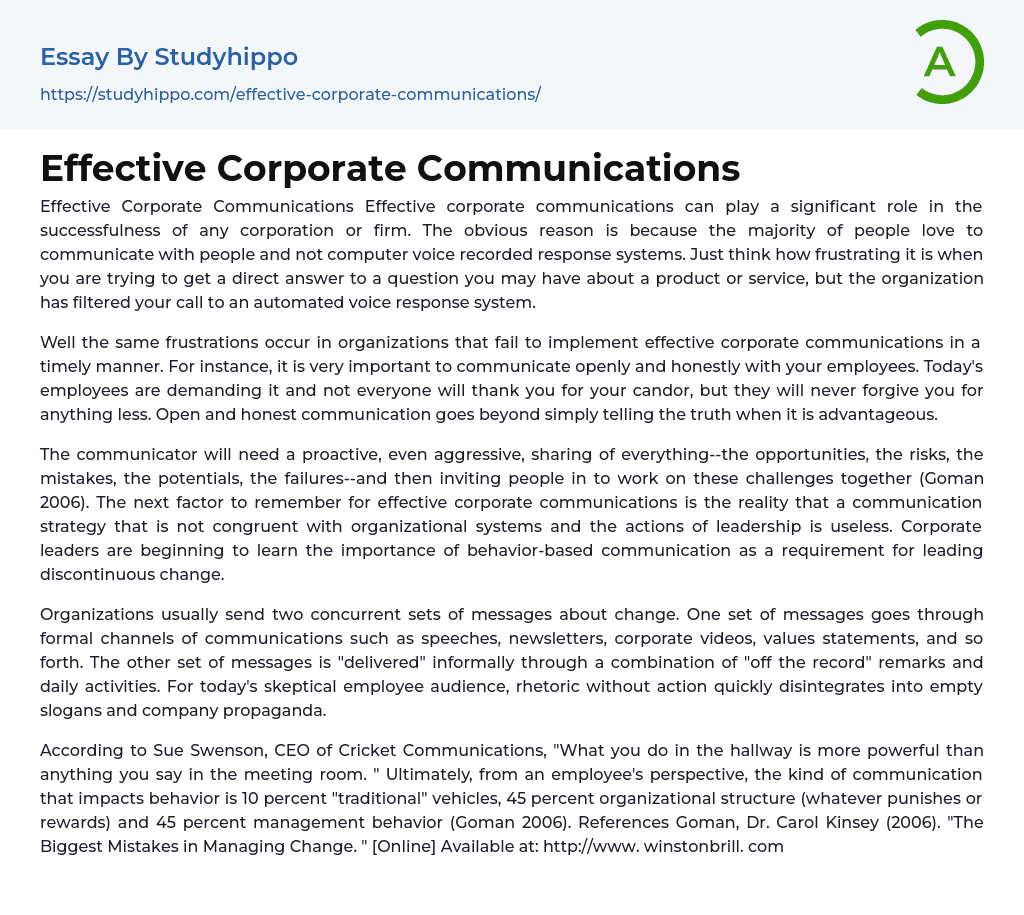Effective Corporate Communications Effective corporate communications can play a significant role in the successfulness of any corporation or firm. The obvious reason is because the majority of people love to communicate with people and not computer voice recorded response systems. Just think how frustrating it is when you are trying to get a direct answer to a question you may have about a product or service, but the organization has filtered your call to an automated voice response system.
Well the same frustrations occur in organizations that fail to implement effective corporate communications in a timely manner. For instance, it is very important to communicate openly and honestly with your employees. Today's employees are demanding it and not everyone will thank you for your candor, but they will never forgive you for anything less. Open and honest communication goes beyond simply telling the truth
...when it is advantageous.
The communicator will need a proactive, even aggressive, sharing of everything--the opportunities, the risks, the mistakes, the potentials, the failures--and then inviting people in to work on these challenges together (Goman 2006). The next factor to remember for effective corporate communications is the reality that a communication strategy that is not congruent with organizational systems and the actions of leadership is useless. Corporate leaders are beginning to learn the importance of behavior-based communication as a requirement for leading discontinuous change.
Organizations usually send two concurrent sets of messages about change. One set of messages goes through formal channels of communications such as speeches, newsletters, corporate videos, values statements, and so forth. The other set of messages is "delivered" informally through a combination of "off the record
remarks and daily activities. For today's skeptical employee audience, rhetoric without action quickly disintegrates into empty slogans and company propaganda.
According to Sue Swenson, CEO of Cricket Communications, "What you do in the hallway is more powerful than anything you say in the meeting room. " Ultimately, from an employee's perspective, the kind of communication that impacts behavior is 10 percent "traditional" vehicles, 45 percent organizational structure (whatever punishes or rewards) and 45 percent management behavior (Goman 2006). References Goman, Dr. Carol Kinsey (2006). "The Biggest Mistakes in Managing Change. " [Online] Available at: http://www. winstonbrill. com
- Chief Executive Officer essays
- Convenience Store essays
- Firm essays
- Training And Development essays
- Unilever essays
- Variable Cost essays
- Virgin Group essays
- Bargaining essays
- Entity essays
- Pest analysis essays
- Being A Leader essays
- Servant Leadership essays
- Leadership Experience essays
- Leadership Qualities essays
- John Locke essays
- 9/11 essays
- A Good Teacher essays
- A Healthy Diet essays
- A Modest Proposal essays
- A&P essays
- Academic Achievement essays
- Achievement essays
- Achieving goals essays
- Admission essays
- Advantages And Disadvantages Of Internet essays
- Alcoholic drinks essays
- Ammonia essays
- Analytical essays
- Ancient Olympic Games essays
- APA essays
- Arabian Peninsula essays
- Argument essays
- Argumentative essays
- Art essays
- Atlantic Ocean essays
- Auto-ethnography essays
- Autobiography essays
- Ballad essays
- Batman essays
- Binge Eating essays
- Black Power Movement essays
- Blogger essays
- Body Mass Index essays
- Book I Want a Wife essays
- Boycott essays
- Breastfeeding essays
- Bulimia Nervosa essays
- Business essays
- Business Process essays
- Canterbury essays




